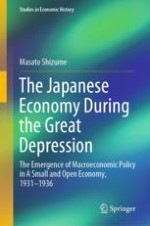2021 | OriginalPaper | Chapter
2. Japan’s Plunge into and Emergence from the Great Depression
Author : Masato Shizume
Published in: The Japanese Economy During the Great Depression
Publisher: Springer Singapore
Activate our intelligent search to find suitable subject content or patents.
Select sections of text to find matching patents with Artificial Intelligence. powered by
Select sections of text to find additional relevant content using AI-assisted search. powered by
